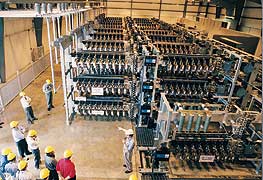 |
| THE FUTURE Solid-state electronic equipment increases operator control of power flows. (Photo courtesy of The Electric Power Research Institute) |
Rapid changes in technology, the economy and society have outpaced the rate of change in the U.S. electricity industry and especially in the transmission grid. Now, that industry has moved to center stage. The battles to shape its future will center on enhancing capacity, updating technology, modernizing its institutions and clarifying its regulatory structure.
New Mexico Gov. Bill Richardson (D) fired the opening shot Aug. 14 when he told a television interviewer that the U.S. is a superpower with a Third-World transmission infrastructure. His former position as President Clintons energy secretary lent weight to his statement. But few industry insiders agree with it.
The grid "is decent, but its been neglected," says Walt Womack, vice president and general manager of transmission and distribution for Burns & McDonnell, Kansas City.
Electric demand grew 35% between 1992 and 2002 while transmission capacity grew only 18%, says Luther Dow, director of power delivery and markets at the Electric Power Research Institute, Palo Alto, Calif. In recent years, transmission has been almost stagnant. Between 1998 and 2007, EPRI projects 17% growth in demand, but only 4% growth in transmission. "They only did the absolute bare minimum," he says.
Regulatory uncertainty has dried up investment in the grid, sources agree. Many point to the power industrys incomplete deregulation, stalled by Californias disastrous experiment and the collapse of Enron and other energy traders. The Federal Energy Regulatory Commissions mandate also is evolving as the Bush administration seeks more authority for the agency to site transmission lines and to enforce market rules.
The grid needs increased capacity and new technology, says Dow. "You have 1950s and 1960s technology running 21st Century equipment." Newer technology would make it easier to interrupt load, improve power quality, enable high-speed tripping and improve control of the grid. He says the cost to upgrade the grid could run $100 billion over 10 years. This investment would match transmission capacity with load growth and would introduce new technology. "We would catch up and keep up," says Dow.
George C. Loehr says a failed experiment with deregulation set up the industry for this blackout. Loehr, an Albuquerque-based transmission consultant and retired executive director of the Northeast Power Coordinating Council, one of the NERC reliability councils, says deregulation has increased the complexity of the industry by breaking up vertically integrated utility companies into transmission owners, generation owners, power marketers and other service providers. The fragmentation also has given economics a priority equal to or higher than reliability. "One economist told me, If anyone told me he was worried about reliability, Id downgrade his companys bond rating," Loehr says.
Loehr also suggests that the trend to ever-larger transmission interconnections may be ill-advised. He says one reason the 2003 blackout is more extensive than the 1965 blackout is that "electrically, everythings closer together." With the AC transmission additions since 1965, "now, theres less electrical impedance between New York and Chicago than there was between New York and Albany." Instead of creating a few large interconnections of AC lines, he would prefer to see many smaller AC interconnections linked by DC lines. That structure would make vast, cascading blackouts impossible.
Jack Hawks, the Electric Power Supply Associations vice president for public affairs and planning, says Congress should not just focus on reliability "because there are...a number of other things that the industry needs in the legislation that would reduce the regulatory uncertainty thats plagued the power industry for the better part of a decade. Mandatory reliability standards, which is pretty much a consensus item, is just one of those elements," he adds.
Hawkss group also favors including provision to encourage regional transmission organizations and regional markets that FERC has been working on through its orders. He also says the House-passed version of the energy bill has tax incentives to encourage spending on transmission lines.
Click below for more articles>>
![]() Reliability Standards Fail Test And Investigators Ask Why
Reliability Standards Fail Test And Investigators Ask Why
![]() When the NorthEast Power Grid Trips, Interlinked Networks Stumble As Well
When the NorthEast Power Grid Trips, Interlinked Networks Stumble As Well
|

Post a comment to this article
Report Abusive Comment